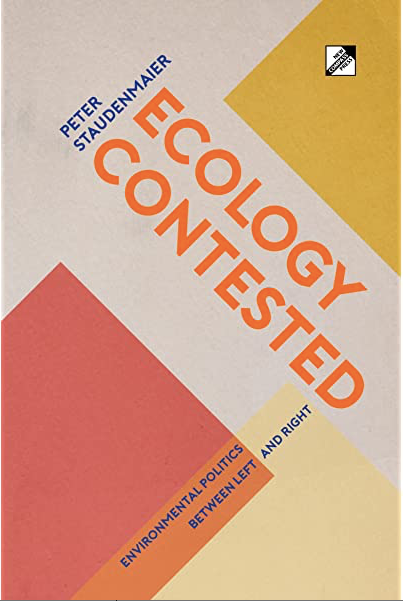Ecofascism: Lessons from the German Experience was published when the American ecology movement debated social critique on one hand, or Malthusianism and anti-humanism on the other. Its authors Janet Biehl and Peter Staudenmaier pointed to historic far-right environmentalism as a warning.
The subject again gained attention in 2019 when a white supremacist gunned down 51 people at two New Zealand mosques. While he murdered friends and families in their places of worship, the attack was posted online for the world to see. “In his shoddy manifesto, the accused shooter in Christchurch identified as an ‘eco-fascist,’” reports Jason Wilson for the Guardian. A few months later another shooter in El Paso, Texas killed 23 people at a Walmart and cited the Christchurch perpetrator as inspiration.
“There have been significant links between environmentalism and Right-wing politics for more than a century,” Staudenmaier writes in his new book Ecology Contested: Environmental Politics Between Left and Right. “Knowingly or not, the perpetrators of the Christchurch and El Paso massacres continued that tradition. While they were unusual in putting their beliefs into violent action, many of the same basic ideas run through the contemporary far Right scene as well as substantial parts of the political mainstream.”
Staudenmaier’s concern is confronting these ideas. His new book hands readers the theoretical basis for a critical and historically-informed engagement with them. Earlier versions of some essays in the volume were published previously. “Disney Ecology” was first put out as a pamphlet, while “Ambiguities of Animal Rights” originally appeared in the journal Communalism. “The Politics of Nature from Left to Right” was written for the second issue of Harbinger. The remaining texts are new.
The most important is “Blood and Soil Revived?” A number of headlines had this term after Alt-Right agitators held torch-lit rallies during what has been named the Summer of Hate. Staudenmaier notes, “When white supremacists chanted ‘blood and soil’ while marching through the streets of Charlottesville in 2017, they heralded a renewal of Nazi rhetoric in an unexpected and unsettling context.” But perhaps this should be less unexpected than it appears.
“Odious incidents like the El Paso attack are not solitary episodes or simply products of deviance,” he continues. “The implicit blood and soil premises in mainstream thought are closer in motive to such drastic acts than some might want to admit.” Such notions have actually existed within the American environmental movement for a long time; many of the founders of conservationism in the US felt fears of racial degeneration, and combined wilderness preservation with eugenics, racism and immigration restriction.
These ideas are also not limited to the US or Germany. Staudenmaier makes this clear, looking at more than a century of European ecofascism–from the nineteenth century to its current revival. At a moment where we are faced with a resurgent far-Right and ecological crises, understanding the past can help orient our actions in the present. “Studying the history of Right-wing ecology can help contemporary activists learn more about the pitfalls their predecessors encountered and the dilemmas they faced.”
Yet current conflicts grab our attention. Reading from a statement titled “The Alt-Right is Green,” Staudenmaier notes, “In the contemporary alt-right mindset, ‘conserving the environment goes hand-in-hand with conserving the White race.” The natural beauty of what is supposedly white man’s land is threatened by contamination, making population decline in the third world an ecological imperative; fewer people equals less pollution in this alt-right document.
“This confused reasoning is the impetus behind the growing turn to eco-nationalism on the American far-Right, and an uncomfortable indication of the diminishing space between extreme and mainstream viewpoints,” Staudenmaier explains. “Alt-right arguments along these lines are dismayingly similar to the stances held by ‘overwhelmingly white, Western, and affluent environmentalists that frame population control in the Global South as a potential solution for climate change.’” An emphasis on population is a theme of Right-wing ecology with significant potential for mainstream crossover.
The perpetrator of the 2019 Christchurch attack described himself as an ecofascist in his manifesto. Here Staudenmaier finds ideas with historical and current presence in Right-wing discourses. “Under the heading ‘Green nationalism is the only true nationalism,’ the manifesto lamented ‘the continued destruction of the natural environment’ through ‘mass immigration and uncontrolled urbanization,’” he reads. “Unless the ‘enemies of our race’ are stopped, the ‘natural environment’ will continue to be ‘industrialized, pulverized and commoditized.’”
Lamenting growing populations, expanding cities, and the racial and cultural replacement of European people, the manifesto labels racialized people responsible for overpopulation and calls for their deaths. “As if to justify his slaughter of fifty-one peaceful children and adults, the perpetrator urged: ‘The invaders are the ones over populating the world. Kill the invaders, kill the overpopulation and by doing so save the environment.’”
Shocking as the shootings in Christchurch and El Paso are, we can easily recognize the myths that motivated them. They have been mentioned throughout this review, and are longstanding parts of the mainstream and radical right. Peter Staudenmaier’s Ecology Contested gives readers a starting point for research and resistance.
Interested in learning more about ecofascism, the threat it poses, and how to defeat it? Sign up for our new class, taught by Peter Staudenmaier and three other experts on reactionary ecological thought.


